1993 CHEVROLET CAVALIER maintenance
[x] Cancel search: maintenancePage 264 of 308
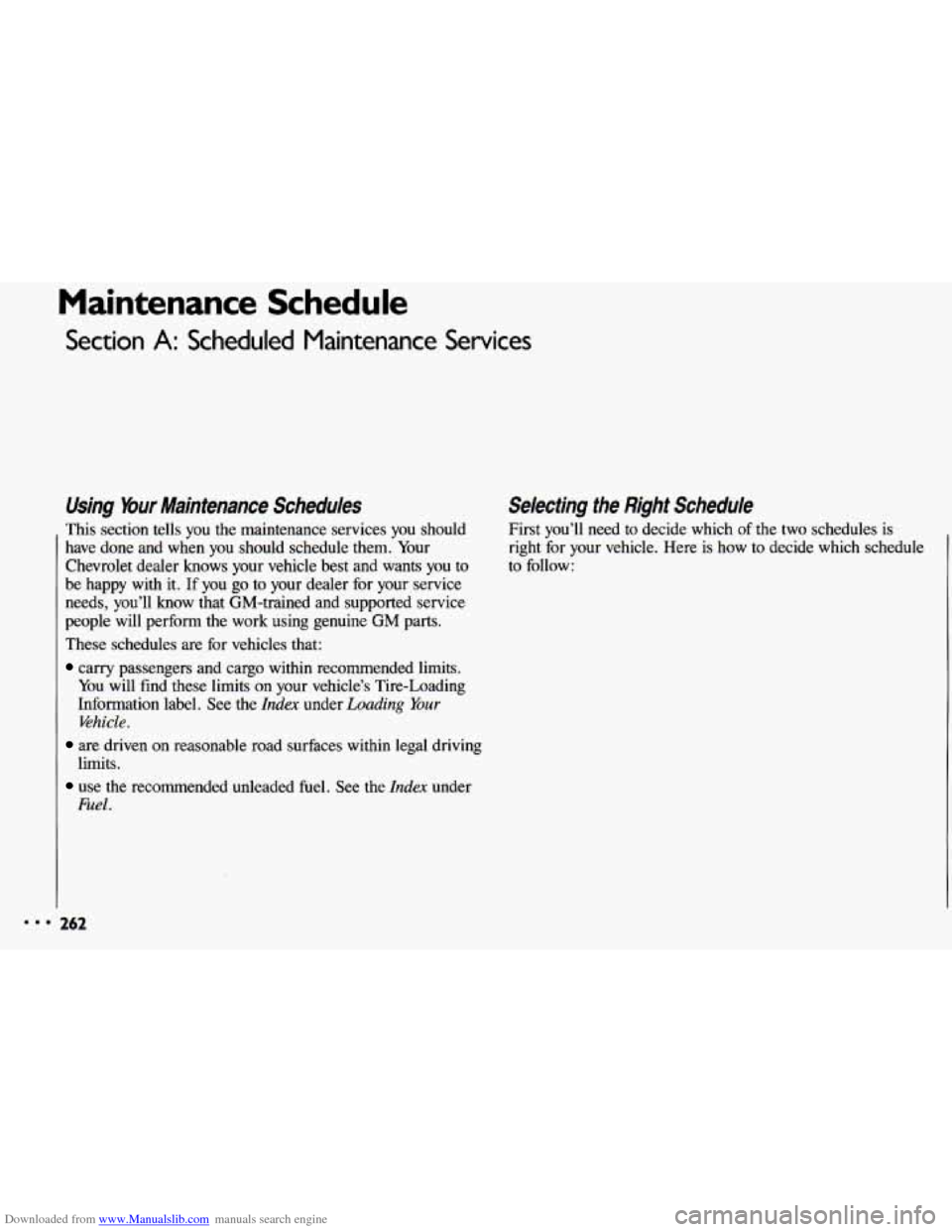
Downloaded from www.Manualslib.com manuals search engine Maintenance Schedule
Section A: Scheduled Maintenance Services
Using bur Maintenance Schedules
This section tells you the maintenance services you should
have done and when you should schedule them. Your
Chevrolet dealer knows your vehicle best and wants you to
be happy with it. If you go to your dealer for your service
needs, you’ll know that GM-trained and supported service
people will perform the work using genuine
GM parts.
These schedules are for vehicles that:
carry passengers and cargo within recommended limits.
You will find these limits on your vehicle’s Tire-Loading
Information label. See the
Index under Loading Your
Ehicle.
limits.
Fuel.
are driven on reasonable road surfaces within legal driving
use the recommended unleaded fuel. See the Index under
Selecting the Right Schedule
First you’ll need to decide which of the two schedules is
right for your vehicle. Here is how to decide which schedule
I
to follow:
Page 266 of 308
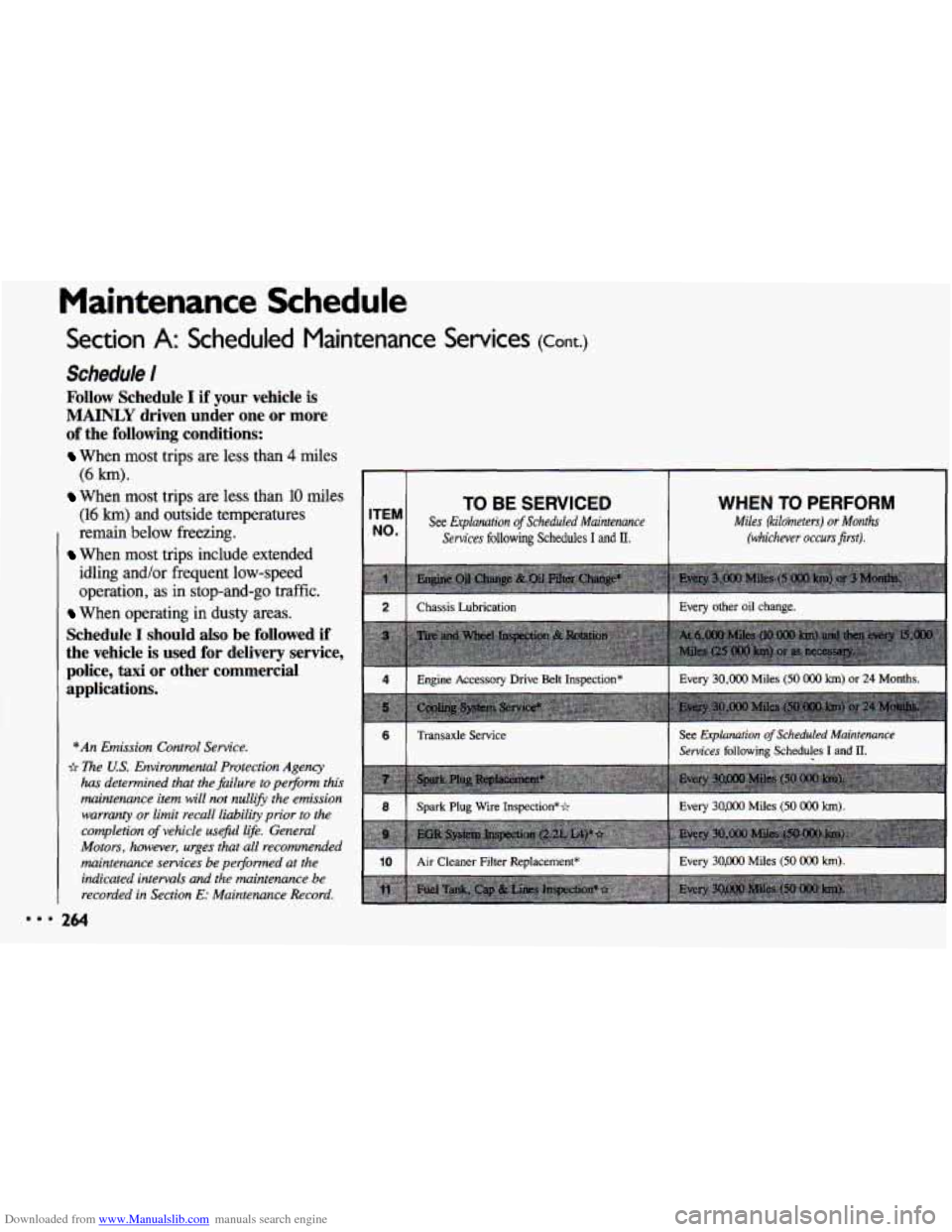
Downloaded from www.Manualslib.com manuals search engine Maintenance Schedule
Section A: Scheduled Maintenance Services (Cont.)
Schedule I
Follow Schedule I if your vehicle is
MAINLY driven under one or more
of the following conditions:
When most trips are less than 4 miles
When most trips are less than 10 miles
(6 km).
(16 km) and outside temperatures
remain below freezing.
When most trips include extended
idling and/or frequent low-speed
operation, as in stop-and-go traffic.
When operating in dusty ,areas.
Schedule I should also be followed if
the vehicle is used for delivery service,
police, taxi
or other commercial
applications.
*An Emission Control Service.
b me US. Environmental Protection Agency
has determined that the failure to pelform this
maintenance item will not
nullifi the emission
warranty or limit recall liability prior to the
completion
of vehicle use&/ life. General
Motors, however, urges that all recommended maintenance services be performed at the indicated intervals and the maintenance be
recorded in Section
E: Maintenance Record.
I I
TO BE SERVICED ITEM
NO. See Explanation of Scheduled Maintenance
Sewices
following Schedules I and II.
WHEN TO PERFORM
Miles (kiloineters) or Months
(whichever
occurs first).
Chassis Lubrication 1 Every other oil change. I
I Engine Accessory Drive Belt Inspection* I Every 30,000 Miles (50 OOO km) or 24 Months. I
(ll
Transaxle Service See Explanation of Scheduled Maintenance
Services
following Schedules I and 11.
I 10 I Air Cleaner Filter Replacement* I Every 30,000 Miles (50 000 km). I
264
Page 268 of 308

Downloaded from www.Manualslib.com manuals search engine Maintenance Schedule
Section A: Scheduled Maintenance Services (Cont.)
Schedule I/
Follow Schedule II ONLY if none of
the driving conditions specified in Schedule
I apply.
*An Emission Control Service.
~2 The US. Environmental Protection Agency
has determined that the failure to pelform this
maintenance item will not nullify the emission warranty or limit recall liability prior
to the
completion
of vehicle useful life. General
Motors, however, urges that all recommended
maintenance services be pei$ormed at the indicated intervals and the maintenance be
recorded in Section E: Maintenance Record.
TO BE SERVICED
See Explanation of Scheduled Maintenance
Services
following Schedules I and II.
WHEN TO PERFORM
Miles (kilometers) or Months
(whichever occursfirst).
I 2 I Chassis Lubrication I Every 7,500 Miles (12 500 km) or 12 Months.
I 4 I Engine Accessory Drive Belt Inspection* I Every 30,000 Miles (50 OOO km) or 24 Months.
16/
Transaxle Service See Explanation of Scheduled Maintenance Services
following Schedules I and 11.
(!-Spark Plug wire Inspection** I Every 30,000 Miles (50 OOO km).
F] Air Cleaner Filter Replacement* 1 Every 30,000 Miles (50 OOO km).
266
Page 270 of 308
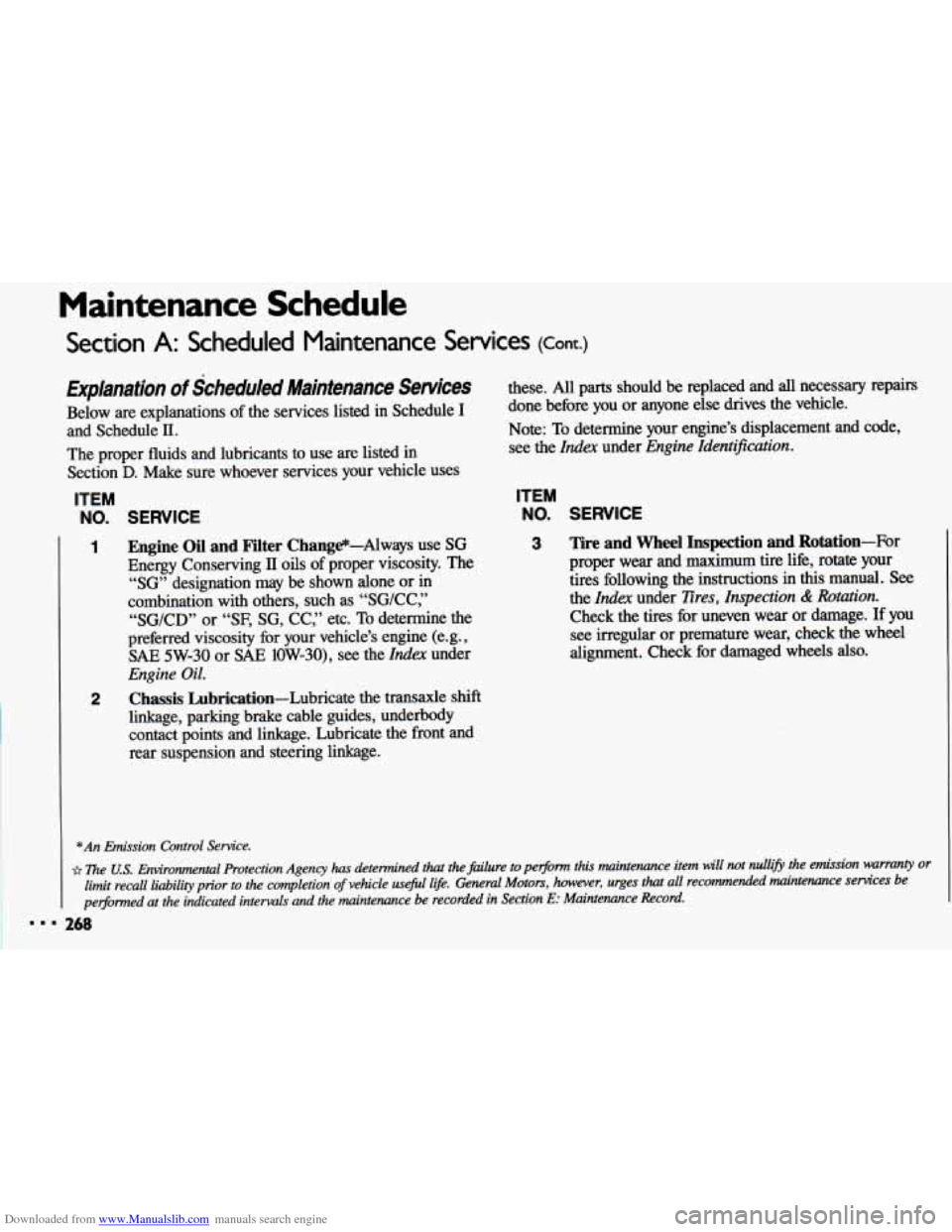
Downloaded from www.Manualslib.com manuals search engine Maintenance Schedule
Section A: Scheduled Maintenance Services (cont.)
Explanation of Scheduled Maintenance Services
Below are explanations of the services listed in Schedule I
and Schedule II.
The proper fluids and lubricants to use are listed in
Section
D. Make sure whoever services your vehicle uses
ITEM
NO. SERVICE
1
2 Engine Oil and Filter Change-Always use SG
Energy Conserving
11 oils of proper viscosity. The
“SG’ designation may be shown alone or in
combination with others, such as “SG/CC,”
“SG/CD” or “SF,
SG, CC,” etc. To determine the
preferred viscosity
for your vehicle’s engine (e.g.,
SAE 5W-30 or SAE 10W-30), see the Index under
Engine Oil.
Chassis Lubrication-Lubricate the transaxle shift
linkage, parking brake cable guides, underbody
contact points and linkage. Lubricate the front and
rear suspension and steering linkage.
Emission Control
Service.
these. All parts should be replaced and all necessary repairs
done before you or anyone else drives the vehicle.
Note: To determine your engine’s displacement and code,
see the Index under Engine Identification.
ITEM
NO.
3
SERVICE
Tire and Wheel Inspection and Rotation-For
proper wear and maximum tire life, rotate your
tires following the instructions
in this manual. See
the Index under Eres, Inspection & Rotation.
Check the tires for uneven wear or damage. If you
see irregular or premature wear, check the wheel
alignment. Check for damaged wheels also.
Page 272 of 308
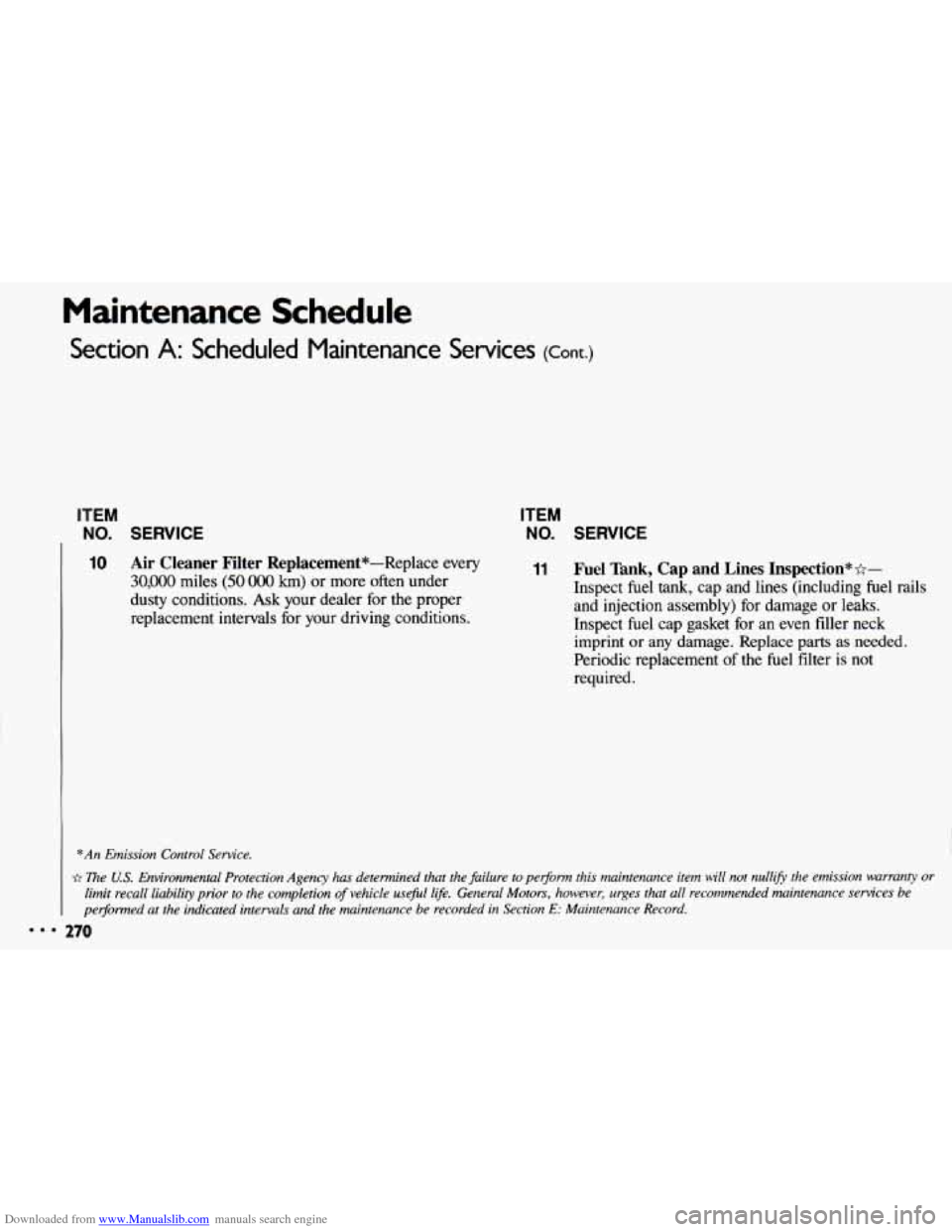
Downloaded from www.Manualslib.com manuals search engine Maintenance Schedule
Section A: Scheduled Maintenance Services (Cont.)
ITEM
NO. SERVICE
10 Air Cleaner Filter Replacement*-Replace every
30,000 miles (50 OOO km) or more often under
dusty conditions.
Ask your dealer for the proper
replacement intervals for your driving conditions.
ITEM
NO. SERVICE
11 Fuel Tank, Cap and Lines Inspection**-
Inspect fuel
tank, cap and lines (including fuel rails
and injection assembly)
for damage or leaks.
Inspect fuel cap gasket for an even filler neck
imprint
or any damage. Replace parts as needed.
Periodic replacement of the fuel filter
is not
required.
*An Emission Control Service.
~2 The US. Environmental Protection Agency has determined that the fuilure to pe$orm this maintenance item will not nullijE the emission warranty or
limit recall liability prior to the completion of vehicle usefirl life. General Motors, however, urges that all r\
ecommended maintenance sewices be
per$ormed at the indicated intervals and the maintenance be recorded in Section
E: Maintenance Record.
270
Page 274 of 308
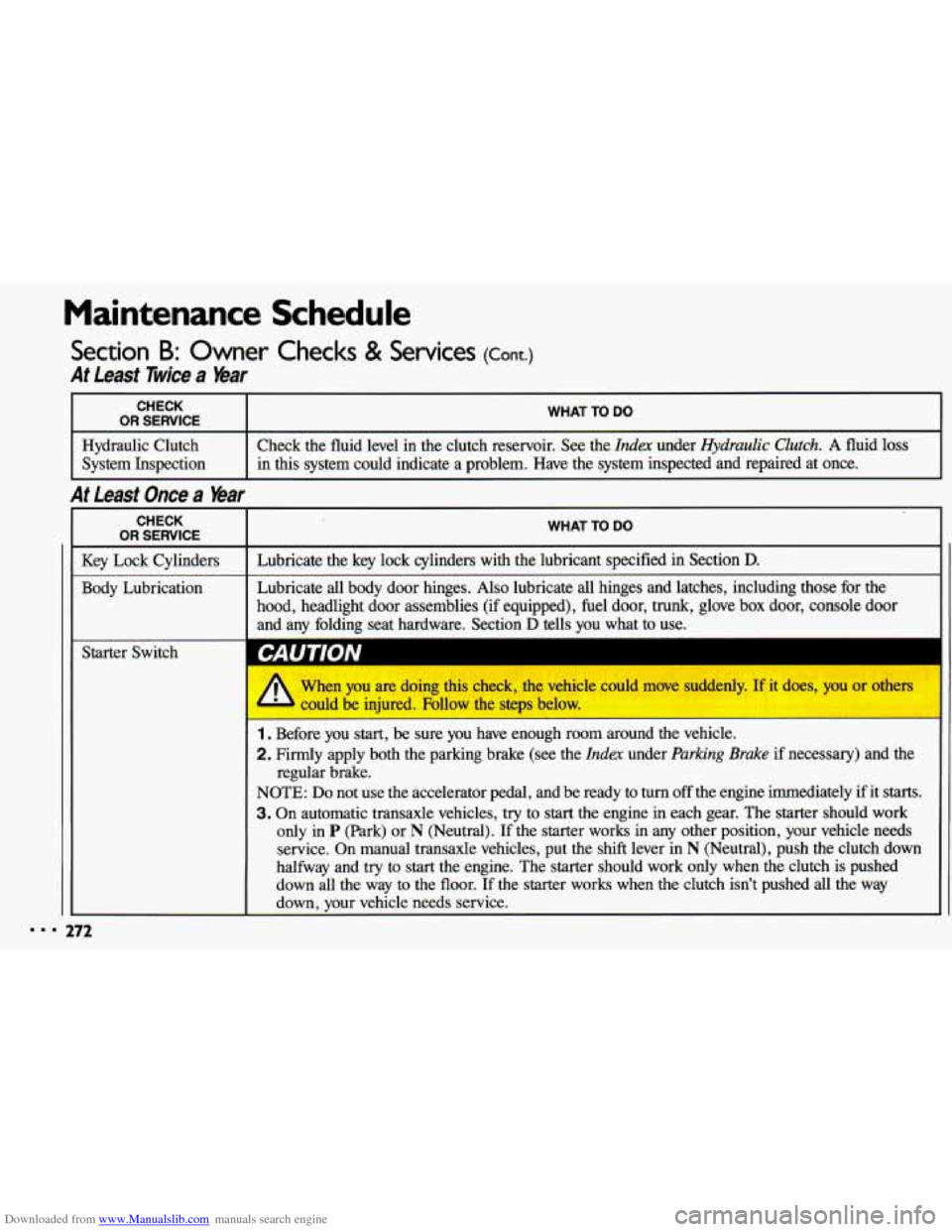
Downloaded from www.Manualslib.com manuals search engine Maintenance Schedule
Section B: Owner Checks & Services (Cont.)
At Least Twice a Year
... L
CHECK
I OR SERVICE I WHAT TO DO
Hydraulic Clutch
in this system could indicate a problem. Have the system inspected and repaired at once. System Inspection
Check
the fluid level in the clutch reservoir. See the Index under Hydraulic Clutch. A fluid loss
At Least Once a Year
CHECK
I OR SERVICE I WHAT TO DO
I
Key Lock Cylinders I Lubricate the key lock cylinders with the lubricant specified in Section D.
Body Lubrication Lubricate all body
door hinges. Also lubricate all hinges and latches, including those \
for the
hood, headlight door assemblies (if equipped), fuel door, trunk, glove box door, console door
and any folding seat hardware. Section
D tells you what to use.
L
272
I CAUTION
1. Before you start, be sure you have enough room around the vehicle.
2. Firmly apply both the parking brake (see the Index under Parking Brake if necessary) and the
NOTE:
Do not use the accelerator pedal, and be ready to turn off the engine immediately if it starts.
3. On automatic transaxle vehicles, try to start the engine in each gear. The starter should work
only in P (Park) or N (Neutral). If the starter works in any other position, your vehicle needs
service. On manual transaxle vehicles, put the shift lever in
N (Neutral), push the clutch down
halfway and
try to start the engine. The starter should work only when the clutch is pushed
down all the way to the floor. If the starter works when the clutch isn’t pushed all the way
down, your vehicle needs service.
regular brake.
I
Page 276 of 308
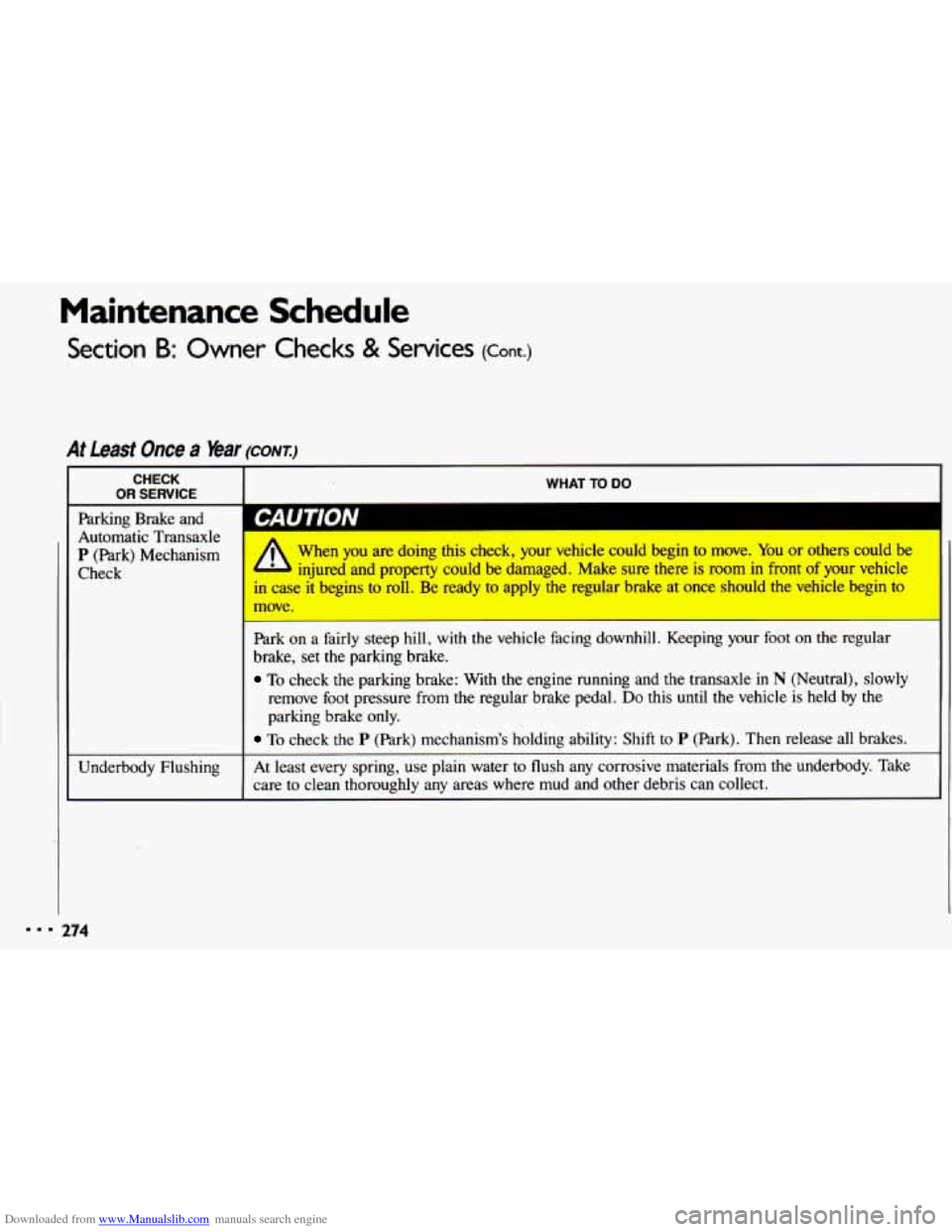
Downloaded from www.Manualslib.com manuals search engine Maintenance Schedule
Section B: Owner Checks & Services (Cont.)
At Least Once a Year (CONT:)
CHECK
OR SERVICE WHAT TO DO ~~
Parking Brake and
Automatic
Transaxle
P (Park) Mechanism When you are doing this check, your vehicle could begin to move. You or others could be I
Check A injured and property could be damaged. Make sure there is room in front of your vehicle
in case it begins to roll. Be ready to ~ ~ )ly the -gular brake at onc - Thould the vehicle begin to
Park on a fairly steep
hill, with the vehicle facing downhill. Keeping your foot on the regular
brake, set the parking brake.
To check the parking brake: With the engine running and the transaxle in N (Neutral), slowly
remove
foot pressure from the regular brake pedal. Do this until the vehicle is held by the
parking brake only.
To check the P (Park) mechanism’s holding ability: Shift to P (Park). Then release all brakes.
Underbody Flushing At least every spring, use plain water to flush any corrosive materials from the unde\
rbody. Take
I care to clean thoroughly any areas where mud and other debris can collect.
274
Page 277 of 308
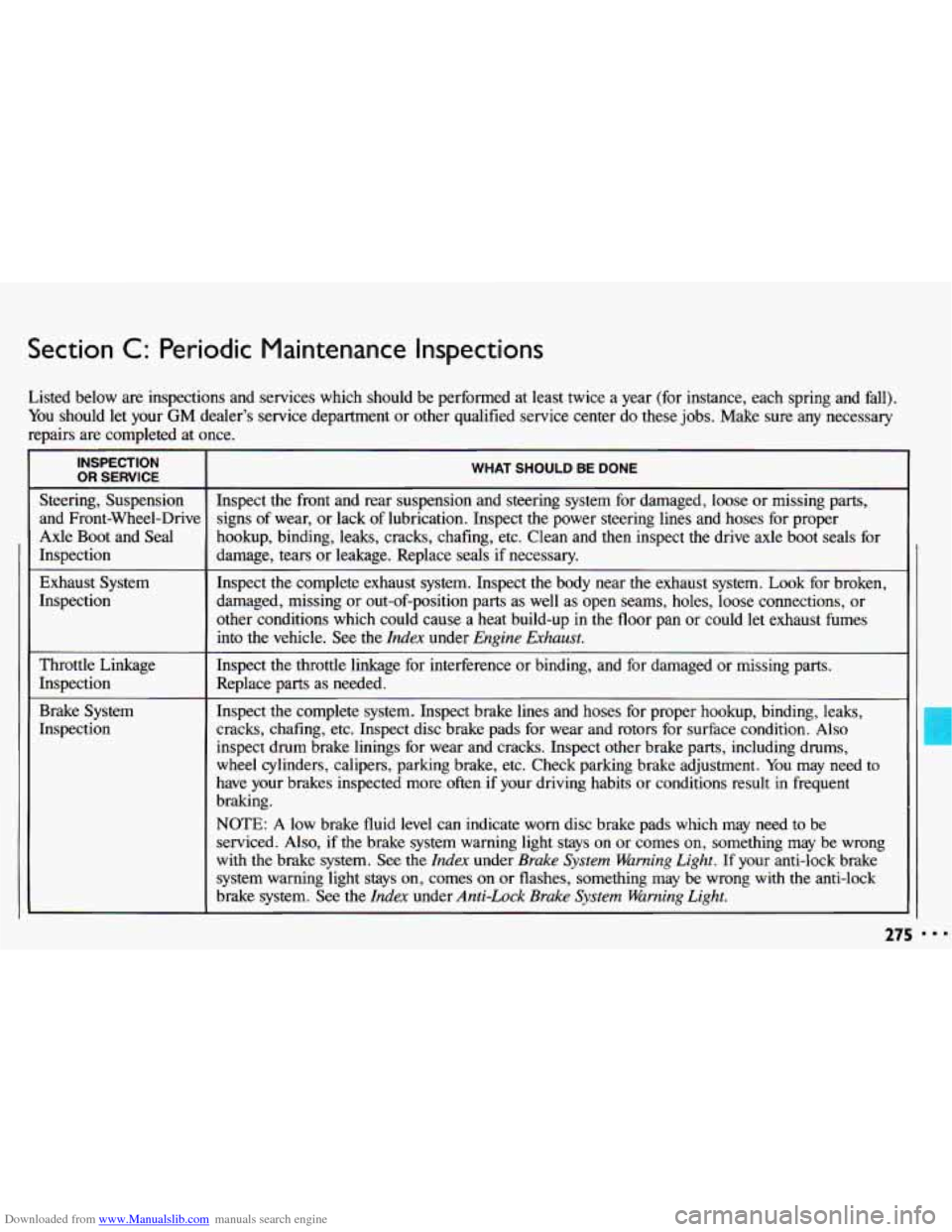
Downloaded from www.Manualslib.com manuals search engine Section C: Periodic Maintenance Inspections
Listed below are inspections and services which should be performed at least twice a year (for instance, each spring and fall).
You should let your GM dealer’s service department or other qualified service center do these jobs. Make sure any necessary
repairs are completed at once.
INSPECTION
I OR SERVICE
Steering, Suspension
and Front-Wheel-Drive
Axle Boot and Seal
1 Inspection
Exhaust System
Inspection
Throttle Linkage
Inspection
WHAT SHOULD BE DONE
Inspect the front and rear suspension and steering system for \
damaged, loose or missing parts,
signs of wear, or lack of lubrication. Inspect the power steering lines and hoses for proper
hookup, binding, leaks, cracks, chafing, etc. Clean and then in\
spect the drive axle boot seals for
damage, tears or leakage. Replace seals
if necessary.
Inspect the complete exhaust system. Inspect the body near
the exhaust system. Look for broken,
damaged, missing or out-of-position parts as well as open seams, holes, loose connections, or
other conditions which could cause a heat build-up in the floor pan or could let exhaust fumes
into the vehicle. See the
Index under Engine Exhaust.
Inspect the throttle linkage for interference or binding, and for damaged or missing parts.
Replace parts
as needed.
Inspect the complete system. Inspect brake lines and hoses for \
proper hookup, binding, leaks,
cracks, chafing, etc. Inspect disc brake pads for wear and rotors for \
surface condition. Also
inspect drum brake linings for wear and cracks. Inspect other brake parts, including drums,
wheel cylinders, calipers, parking brake, etc. Check parking brake adjustment. You may need to
have your brakes inspected more often
if your driving habits or conditions result in frequent
braking.
NOTE: A low brake fluid level can indicate worn disc brake pads which \
may need to be
serviced. Also,
if the brake system warning light stays on or comes on, something may be wrong
with the brake system. See the
Index under Brake System Warning Light. If your anti-lock brake
system warning light stays on, comes on or flashes, something may be wrong with the anti-lock
brake system. See the
Index under Anti-Lock Brake System Warning Light.
275 . .